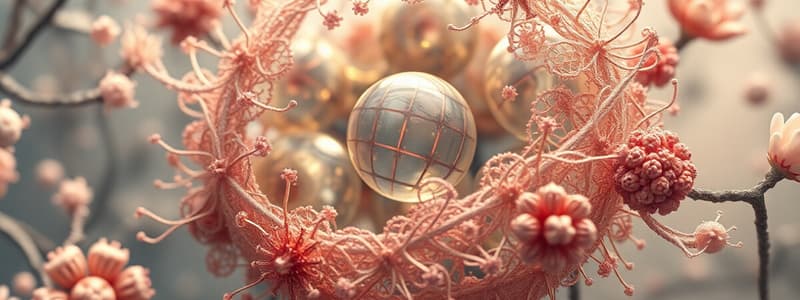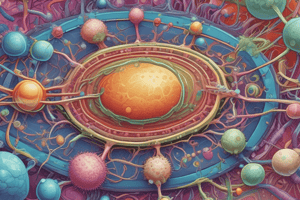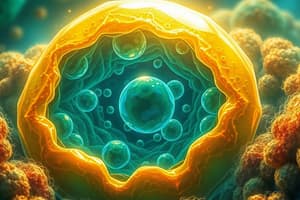Podcast
Questions and Answers
Which of the following is a fundamental difference between prokaryotic and eukaryotic cells?
Which of the following is a fundamental difference between prokaryotic and eukaryotic cells?
- Prokaryotic cells have a nucleus, while eukaryotic cells do not.
- Neither cell type has a nucleus.
- Both cell types have a nucleus.
- Eukaryotic cells have a nucleus, while prokaryotic cells do not. (correct)
Which of the following domains consists of prokaryotic cells?
Which of the following domains consists of prokaryotic cells?
- Fungi and Animals
- Plants and Animals
- Protists and Fungi
- Bacteria and Archaea (correct)
What is the typical size range of prokaryotic cells?
What is the typical size range of prokaryotic cells?
- 50-200 μm
- 10-100 μm
- 100-500 μm
- 0.5-5 μm (correct)
In prokaryotic cells, where is the DNA concentrated?
In prokaryotic cells, where is the DNA concentrated?
What is the main function of ribosomes?
What is the main function of ribosomes?
What is the main component of bacterial cell walls?
What is the main component of bacterial cell walls?
Which structure helps prokaryotes attach to surfaces?
Which structure helps prokaryotes attach to surfaces?
Which organelle houses the cell's DNA in eukaryotic cells?
Which organelle houses the cell's DNA in eukaryotic cells?
Which of the following is part of the endomembrane system?
Which of the following is part of the endomembrane system?
Which organelle is responsible for cellular respiration?
Which organelle is responsible for cellular respiration?
What is the function of chloroplasts?
What is the function of chloroplasts?
What is the function of the nuclear envelope?
What is the function of the nuclear envelope?
Where are ribosomes assembled?
Where are ribosomes assembled?
Which type of endoplasmic reticulum (ER) has ribosomes on its surface?
Which type of endoplasmic reticulum (ER) has ribosomes on its surface?
What is the main function of the Golgi apparatus?
What is the main function of the Golgi apparatus?
What is the role of lysosomes in the cell?
What is the role of lysosomes in the cell?
What is a primary function of vacuoles in plant cells?
What is a primary function of vacuoles in plant cells?
Which structure provides support and shape to plant cells?
Which structure provides support and shape to plant cells?
What is the function of the cytoskeleton?
What is the function of the cytoskeleton?
What is the extracellular matrix (ECM)?
What is the extracellular matrix (ECM)?
Flashcards
Prokaryotic Cells
Prokaryotic Cells
Cells lacking a nucleus or other membrane-bound organelles; includes Bacteria and Archaea.
Eukaryotic Cells
Eukaryotic Cells
Cells containing a nucleus and other membrane-bound organelles; includes protists, fungi, plants, and animals.
Nucleoid
Nucleoid
Region in a prokaryotic cell where DNA is concentrated, but not enclosed by a membrane.
Capsule (Prokaryotic)
Capsule (Prokaryotic)
Signup and view all the flashcards
Pili (Fimbriae)
Pili (Fimbriae)
Signup and view all the flashcards
Nuclear Envelope
Nuclear Envelope
Signup and view all the flashcards
Endoplasmic Reticulum (ER)
Endoplasmic Reticulum (ER)
Signup and view all the flashcards
Golgi Apparatus
Golgi Apparatus
Signup and view all the flashcards
Lysosomes
Lysosomes
Signup and view all the flashcards
Vacuoles
Vacuoles
Signup and view all the flashcards
Mitochondria
Mitochondria
Signup and view all the flashcards
Chloroplasts
Chloroplasts
Signup and view all the flashcards
Cytoskeleton
Cytoskeleton
Signup and view all the flashcards
Microtubules
Microtubules
Signup and view all the flashcards
Microfilaments
Microfilaments
Signup and view all the flashcards
Cell Wall (Plant)
Cell Wall (Plant)
Signup and view all the flashcards
Extracellular Matrix (ECM)
Extracellular Matrix (ECM)
Signup and view all the flashcards
Chromosomes
Chromosomes
Signup and view all the flashcards
Nucleolus
Nucleolus
Signup and view all the flashcards
Ribosomes
Ribosomes
Signup and view all the flashcards
Study Notes
- Prokaryotes and eukaryotes are the two fundamental types of cells
- Prokaryotes include Bacteria and Archaea; eukaryotes comprise protists, fungi, plants, and animals
- The primary distinction lies in their cellular organization: eukaryotes have a nucleus and other membrane-bound organelles, while prokaryotes do not
Prokaryotic Cell Structure
- Prokaryotic cells are generally smaller (0.5-5 μm) than eukaryotic cells (10-100 μm)
- Prokaryotes lack a true nucleus; their DNA is concentrated in a nucleoid region without a membrane
- The prokaryotic cytoplasm contains ribosomes, which are responsible for protein synthesis
- The cell is enclosed by a plasma membrane, a phospholipid bilayer with embedded proteins
- Most prokaryotes have a cell wall outside the plasma membrane, providing shape and protection; bacterial cell walls contain peptidoglycan
- Some prokaryotes have a capsule, a sticky outer layer for adherence and protection
- Flagella are used by some prokaryotes for movement; they are structurally different from eukaryotic flagella
- Pili (fimbriae) are appendages that help prokaryotes attach to surfaces
Eukaryotic Cell Structure
- Eukaryotic cells are characterized by the presence of a nucleus, which houses the cell's DNA
- The nucleus is surrounded by a nuclear envelope, a double membrane with pores for transport
- The cytoplasm of eukaryotes contains a variety of membrane-bound organelles, each with specific functions
- The endomembrane system includes the endoplasmic reticulum (ER), Golgi apparatus, lysosomes, vacuoles, and plasma membrane
- The endoplasmic reticulum (ER) is involved in protein and lipid synthesis; rough ER has ribosomes, while smooth ER does not
- The Golgi apparatus modifies, sorts, and packages proteins and lipids
- Lysosomes contain enzymes for intracellular digestion
- Vacuoles have various functions, including storage, waste disposal, and maintaining cell turgor
- Mitochondria are responsible for cellular respiration, generating ATP
- Chloroplasts (in plant cells and algae) are the sites of photosynthesis
- The cytoskeleton provides structural support and facilitates cell movement; it includes microtubules, microfilaments, and intermediate filaments
- Eukaryotic cells may have flagella or cilia for movement; these are structurally more complex than prokaryotic flagella
- Plant cells have a cell wall made of cellulose, providing support and protection
Nucleus
- Eukaryotic cells have a defined nucleus which contains most of the cell’s genes
- The nuclear envelope is a double membrane enclosing the nucleus; it contains pores that regulate movement of molecules
- Chromosomes are structures carrying genetic information; each chromosome contains one long DNA molecule associated with proteins
- Chromatin is the complex of DNA and proteins making up chromosomes
- The nucleolus is a region within the nucleus where ribosomal RNA (rRNA) is synthesized and ribosomes are assembled
Ribosomes
- Ribosomes are responsible for protein synthesis
- Eukaryotic ribosomes are larger and more complex than prokaryotic ribosomes
- Ribosomes are found in two locations: free in the cytosol and bound to the endoplasmic reticulum or nuclear envelope
Endoplasmic Reticulum (ER)
- The ER is an extensive network of membranes
- Smooth ER lacks ribosomes; it synthesizes lipids, metabolizes carbohydrates, and detoxifies drugs and poisons
- Rough ER has ribosomes on its surface; it produces proteins and membranes
Golgi Apparatus
- The Golgi apparatus modifies products of the ER, manufactures certain macromolecules, and sorts and packages materials into transport vesicles
- It consists of flattened membranous sacs called cisternae
Lysosomes
- Lysosomes are membranous sacs of hydrolytic enzymes that can digest macromolecules
- They break down cellular waste products and debris
Vacuoles
- Vacuoles are large vesicles derived from the ER and Golgi apparatus
- They perform a variety of functions, including storage, waste disposal, protection, and growth
- Plant cells often have a large central vacuole that stores water and helps maintain cell turgor
Mitochondria
- Mitochondria are the sites of cellular respiration
- They have a double membrane: an outer membrane and an inner membrane with folds called cristae
- The inner membrane creates two compartments: the intermembrane space and the mitochondrial matrix
- The matrix contains enzymes, DNA, and ribosomes
Chloroplasts
- Chloroplasts are found in plants and algae and are the sites of photosynthesis
- They contain chlorophyll, which captures light energy
- Chloroplasts have a double membrane and also contain thylakoids (membranous sacs) and stroma (internal fluid)
Cytoskeleton
- The cytoskeleton is a network of fibers extending throughout the cytoplasm
- It provides structural support and facilitates cell motility and regulation
- It is composed of microtubules, microfilaments, and intermediate filaments
- Microtubules are hollow rods that shape and support the cell and serve as tracks for motor proteins
- Microfilaments are thin, solid rods that function in muscle contraction, cell motility, and cell division
- Intermediate filaments are fibers that provide structural support and anchor organelles
Cell Wall
- Plant cells have a cell wall made of cellulose
- The cell wall provides support, protection, and shape to the cell
- Bacteria have cell walls containing peptidoglycan, while archaea have cell walls composed of other materials
Extracellular Matrix (ECM)
- Animal cells lack cell walls but are covered by an extracellular matrix (ECM)
- The ECM is made up of glycoproteins and other macromolecules
- It provides support, adhesion, movement, and regulation
Intercellular Junctions
- Neighboring cells in tissues often adhere, interact, and communicate through direct physical contact
- Examples include: Plasmodesmata (plants), tight junctions, desmosomes, and gap junctions (animals)
Studying That Suits You
Use AI to generate personalized quizzes and flashcards to suit your learning preferences.




